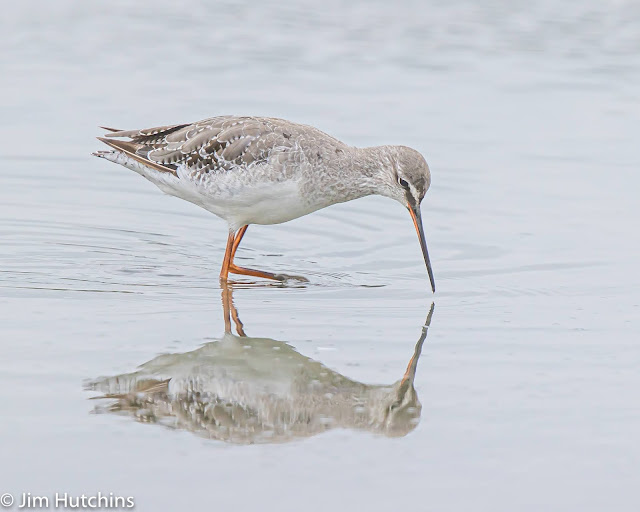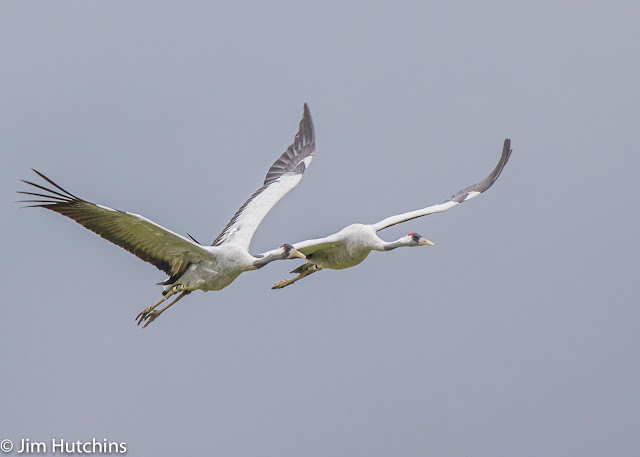 |
| Spotted Redshank |
This time of year is generally known as the summer doldrums by birders. The spring passage is long finished, the autumn passage proper is still at least a month away and all other birds are much too busy raising their young to sit on a tree and look pretty for us. Many birders at this time of year take solace in butterflies and dragonflies but I must confess that this doesn't hit the spot for me.
My recourse in recent years has been my bolt hole at pit 60. Even with little bird activity it is a very pleasant way to spend the morning drinking coffee either on my own or sorting out the world’s problems with local birders Ade and Mick. With this bolt hole fully closed to me this year and the garden pretty much being in sit and enjoy mode, I must confess that I have been at a bit of a loose end so this week I decided to visit the recently reopened Slimbridge. I wanted to avoid the heat forecast from Friday onwards so opted for Thursday which was forecast as light cloud. With the exception of the golden hours at dawn and dusk, I find the overhead sunlight very harsh for photography at this time of year and light cloud normally gives a softer, and to me at least, more pleasing image.
 |
| Common Cranes |
A word of warning if you are planning to visit Slimbridge, to limit numbers you need to book in advance even if you are a member. Also the normal early entry for members is not in operation. All hides have strictly limited occupancy and all windows and doors are left open.
I joined the short socially distanced queue at 09:30 and headed to the south lake where a fairly showy Spotted Redshank has been in residence for the past week or so. The Spotted Redshank was feeding in its normal frantic style in quite deep water some way to the right of the hide, a belated year tick for me in this strange year. It slowly made its way towards the hide, feeding all the time in and out of several hundred Godwits, allowing me to get a few reasonable pics. This is a bird that does a remarkable transformation in the breeding season from a subtly coloured, but nonetheless quite attractive, grey, light brown and white with red bill and legs, to being pretty much completely black from head to toe! This particular bird was moulting and well on the way to its more subtle winter plumage. The other main interest on the south lake were five hyperactive juvenile, i.e. born this spring, Little Ringed Plovers, much paler than adults with just the beginnings of their highly distinctive yellow eye ring. They first bred in the UK in 1938 and have since successfully colonised a large part of England and Wales thanks to man-made habitats such as gravel pits.
 |
| Spotted Redshank |
I moved onto the Zeiss hide and located a distant Greenshank, yet another unusual omission from my year list and hence a year tick. The usual flock of "feral" Barnacle Geese were grazing on the lush grass in front of the hide. I say "feral" in inverted commas as this is what many people say they are, but this is plain daft in my humble opinion! They are a self-sustaining flock that has been present for some fifty years after all!
I spent the rest of my day on the other side of the reserve photographing Common and Green Sandpipers. The Green Sandpipers, often said to be the harbingers of the autumn passage, are probably all females. Along with many other artic breeding waders, the females abandon the young straight after birth and head south leaving all subsequent parental duties to the dad. At one point a Common Sandpiper moved next to a green one and I was truly shocked by how much bigger the green was, all be it that it was puffed-up a little. I’ve probably seen hundreds of Common and Green Sandpipers but, I guess, have never seen them side by side. There was also a small flock of recently returned Dunlin including a number of ginger tinted juveniles.
 |
| Green Sandpiper |
 |
| Green and Common Sandpiper |
 |
| Common Sandpiper |
 |
| Common Sandpiper |
Along with every other single man on the planet, I utterly detest shopping. We can’t help it; this utter loathing is hard written into our DNA. So along with the invention of the wheel, beer and soccer, internet shopping was the best thing that ever happened to us not so fair sex. Recently, however, I have had a bit of a road to Damascus moment after a serious run in with Amazon. The problem arises when you actually need to speak to a real human being with an issue. I brought a new mac pro laptop towards the end of last year which recently developed a major fault with the display which had dancing purple lines all across it. I did a live chat with Amazon who arranged for it to be returned foc for repair, so I sent it off with all the requested paperwork. A week or so later I got a call from the third party repairer whom Amazon had sent it to saying that it was out of warranty and I needed to pay £600 for it to be repaired! No amount of common sense reasoning would convince the caller otherwise as the receipt from Amazon did not have the machines serial number on it. I had the choice of paying or having it sent back so had it sent back. What then followed was an excellent example of appalling customer service, many hours on Amazon live chat trying to sort it out and being promised that someone would call me who never did. I eventually told them at the end of a particularly frustrating chat that I was taking Amazon to the small claims court under the UK Sales of Goods act. Miraculous, this resulted in an immediate offer of a return and full refund. Why on earth could they have not done that at the beginning and saved hours and hours of my time!
Now don’t worry fellow men, I haven’t gone totally soft, I've brought a replacement from Apple ………online!
If the mere mention of the word physics turns you pale and nauseous, look away now. I recently read an article about an experiment which I thought was truly incredible. Most people have an inkling that the world of quantum mechanics is strange and wonderful. For objects at an atomic scale many of the properties that we take for granted in everyday life such as position, velocity etc are only defined by a hazy cloud of probability, called a wave function, until a measurement takes place that collapses the cloud of probability to definitive values. This has all sorts of strange and wonderful implications such as the so called Schrodinger’s cat paradox. It places the observer, through his or her act of measurement, in an odd and unique position in the universe and has led to a whole branch of philosophy in its own right. For instance, what constitutes an observer and why is he or she so special in this quantum world? Does the observer need to be a conscious human being, or could it be, for instance, say a slug of even an amoeba?
One question that has some relevance to this question is does the cloud of probability collapse instantly to definitive values on the act of measurement or is this a process which takes time. In the remarkable experiment someone has actually manged to observe the collapse of the wavefunction and confirmed that it is not instantaneous but takes place continuously over a few nanoseconds. What this measurement says about the nature of the universe I will leave to much brighter people than me to answer!
Comments
Post a Comment